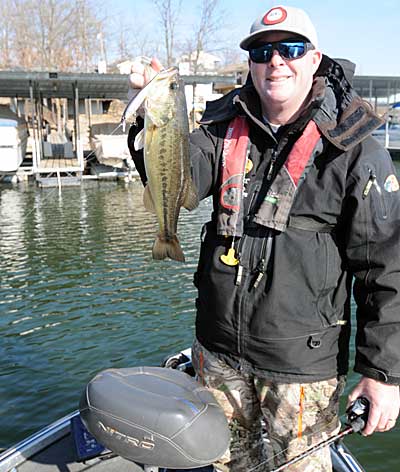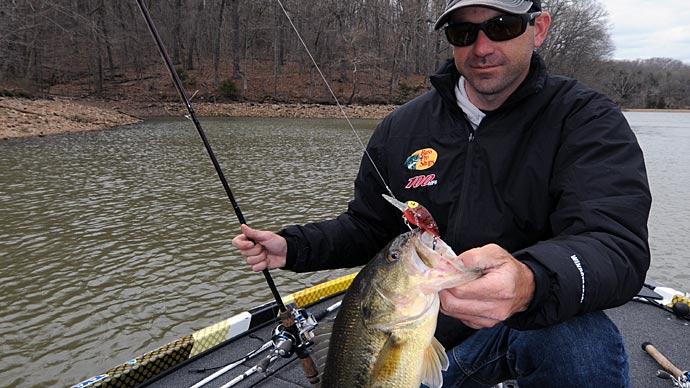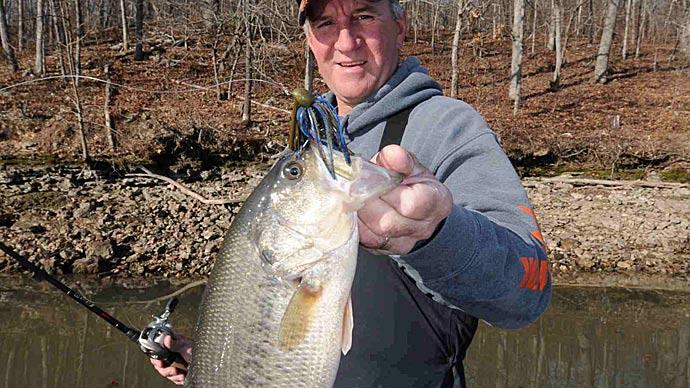
Catching prespawn bass requires some power and a little bit of finesse.
Missouri guide Jack Uxa relies on baitcasting equipment for most of his prespawn power fishing tactics, but sometimes he resorts to finessing bass with spinning gear.
“A spinning rod has a big role to play,” Uxa says. “There is a lot of finesse stuff that I will do once I find the fish. Throughout the year, you will find fish that are grouped up. The prespawn is a tricky time frame, but you have to make the most out of the fish when you find them because you might go a long time without finding them again. If you find one good fish, you must gear down and show those fish multiple lures to make the most out of that school.”
Here is a look at Uxa's gear for the following power and finesse tactics for prespawn bass.
Alabama rig
During the early prespawn, when the water is still cold, Uxa relies on a winter power fishing tactic of slowly winding an Alabama rig adorned with swimbaits.
“You need to have big gear (for the Alabama rig),” Uxa says. “I have previously broken mediocre size equipment such as 7-foot-6 telescoping flipping rods. I broke two of those when the A-rig first came out because they weren’t big enough.”
The third-place finisher in the 2021 MLF Toyota Series tournament at Lake of the Ozarks uses a 7' 9" heavy-action Fenwick Techna AV rod, which he considers more of a musky rod than a bass rod. “You can’t have something heavy because it will wear you down,” Uxa says. “I have talked to many people who don’t want to throw the A-rig because it is obnoxious to throw.” He believes the 7' 9" Techna has the right combination of being powerful enough to handle the Alabama rig yet is still light enough to keep from wearing him down.
Uxa matches his rod with a Lew’s Super Duty 300 baitcast reel (7.2:1 gear ratio) featuring a handle with a single large knob. “I get a lot of leverage with that big knob,” he says. Sixty-five-pound Spiderwire is Uxa’s first line choice for cranking his A-rig, but he will switch to 20-pound fluorocarbon on calm, sunny days when he thinks bass are line-shy.
Suspending stickbaits
Uxa considers twitching a suspending jerkbait a finesse tactic, so he relies on lighter line and tackle. He often works the lure on baitcasting tackle but will switch to spinning gear on windy days to avoid the backlashes that frequently occur when throwing lightweight stickbaits with baitcast reels.
The Missouri angler prefers a shorter rod (6' 3" medium action Abu Garcia Vendetta casting rod) when he fishes a suspending stickbait in the early prespawn because he tends to overwork the lure with longer rods. “I am kind of bad about twitching my jerkbait, maybe a little bit too hard sometimes, particularly with a long rod,” Uxa says. The lighter action rod also prevents Uxa from overpowering bass and pulling out the stickbait’s small treble hooks when fighting the fish.
Uxa favors a 6.4:1 gear ratio Abu Garcia Revo AL-F baitcast reel filled with 8-pound Berkley 100% Fluorocarbon for his prespawn jerkbait tactics.
Crankbaits
The Lake of the Ozarks guide sets up his clients with spinning tackle to throw crankbaits on windy days or cast lighter plugs such as the Rapala Shad Rap. Uxa also casts crankbaits with a spinning tackle on windy days to avoid backlashes, but he relies on baitcast gear for most of his prespawn cranking presentations.

A 6' 9" medium-moderate action Berkley E-MOTION Performance Series composite fiberglass-graphite casting rod is Uxa’s choice for prespawn cranking. “It has a lot more limber tip and can double as a jerkbait rod,” he says.
Uxa ensures he avoids reeling a crankbait too fast or too slow for prespawn bass by employing a 6.4:1 gear ratio baitcast reel. He relies on 10-pound test monofilament line for cranking in the early prespawn when bass are still passive, but he switches to 12-pound line later in the prespawn when he has to bump his crankbaits into the rocky bottom.
Spinnerbaits
A crankbait helps Uxa quickly cover water in the prespawn but switches to a spinnerbait when he finds a suitable target along the bank.
“The spinnerbait is going to be the bait that catches the big one,” Uxa says. “I’m looking for Mr. Big then, so I am using heavier line and making multiple casts around a lot of laydowns.” The tournament competitor slowly winds 1/2- or 3/4-ounce spinnerbaits through the laydown limbs, so he relies on a 7' 2" medium-heavy action rod to winch bass out of the cover. He combines the rod with an 8.3:1 baitcast reel filled with 17-pound fluorocarbon line.
Finesse jigs
Uxa favors lighter lines for pitching small jigs during the early prespawn when the water temperature is in the mid-40s, and he is targeting ledges and drop-offs along open banks. He chooses a 7-foot medium-action casting rod and 7.1:1 or 8.1:1 baitcast reel with 12-pound fluorocarbon line or a 7-foot medium-heavy spinning rod and Abu Garcia Zenon spinning reel with a 15-pound Berkley X9 braid mainline and 10-pound fluorocarbon leader for fishing his finesse jigs.
The Missouri angler upgrades to a 7-foot medium-heavy casting rod and baitcast reel spooled with 15- to 17-pound fluorocarbon for pitching to prespawn bass hanging around brush or behind dock cables.
Ned rigs
“I like a pretty small setup for that,” Uxa says of his Ned rig gear. He opts for a 6' 6" medium action spinning rod and spinning reel with a 20-size spool for casting the small rig. Fishing the rig with 6-pound monofilament generates more bites for Uxa, but he also experiences more breakoffs with the lighter line. When he fishes the rig around cover, Uxa beefs up to 15-pound braid with an 8- or 10-pound fluorocarbon leader.



